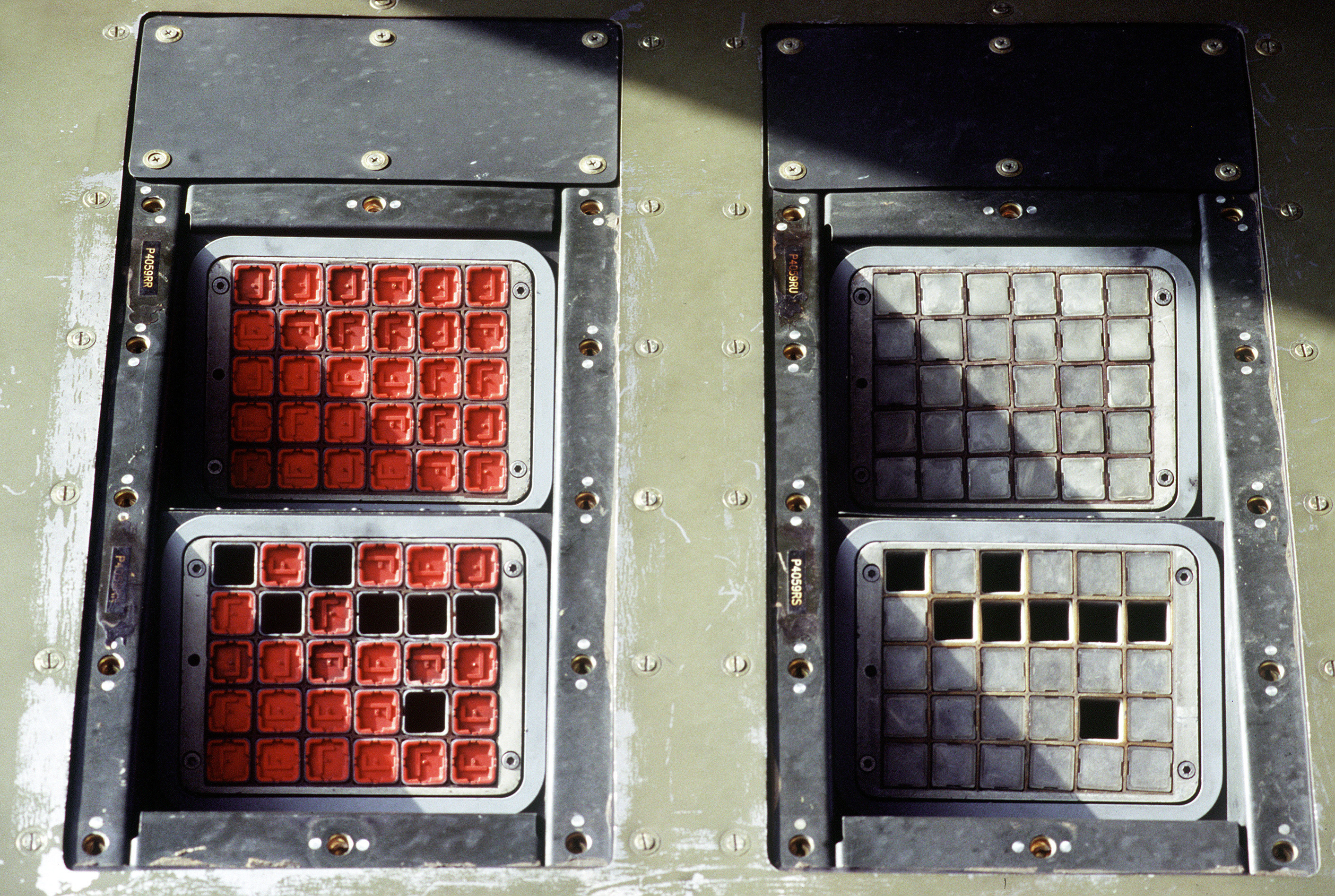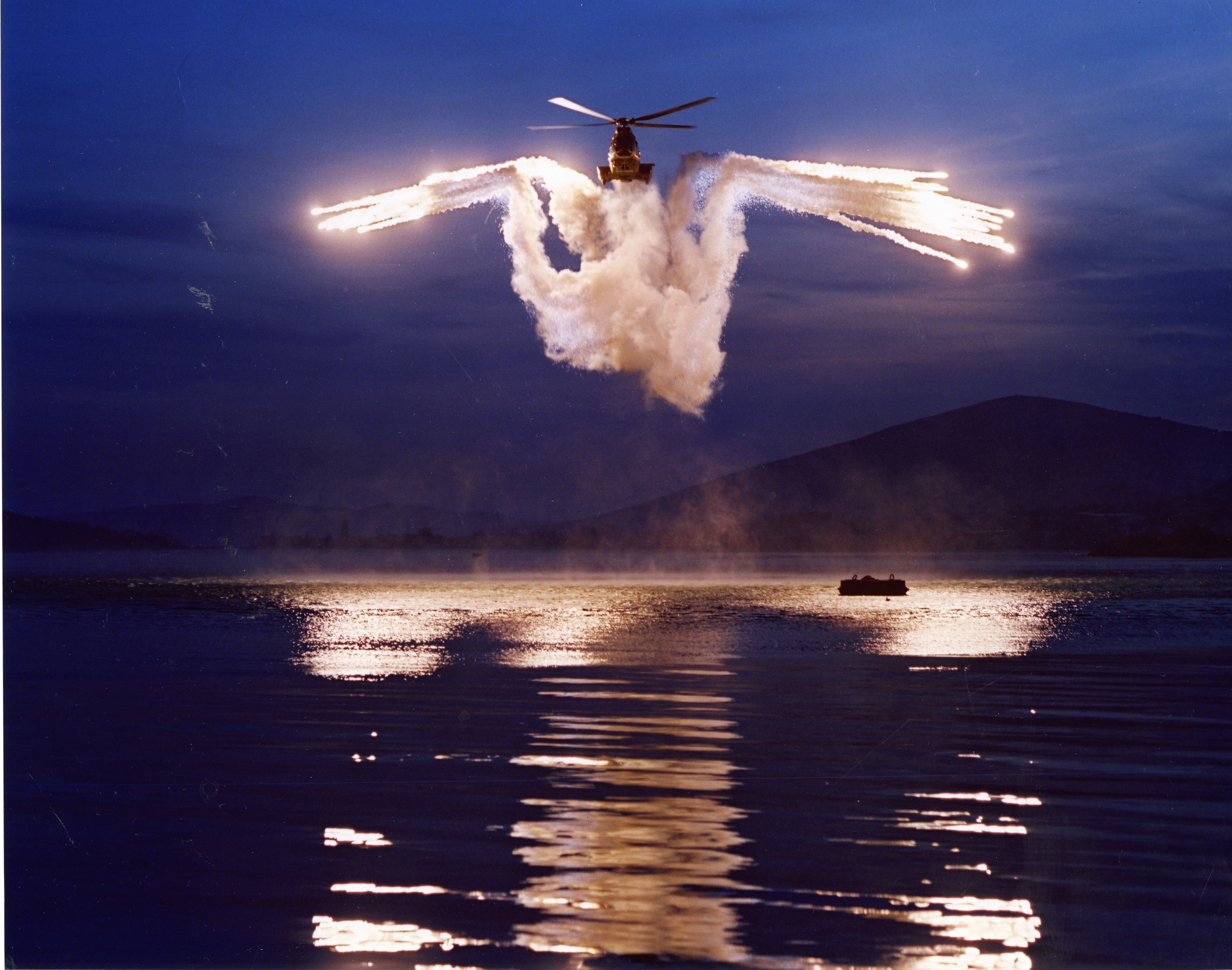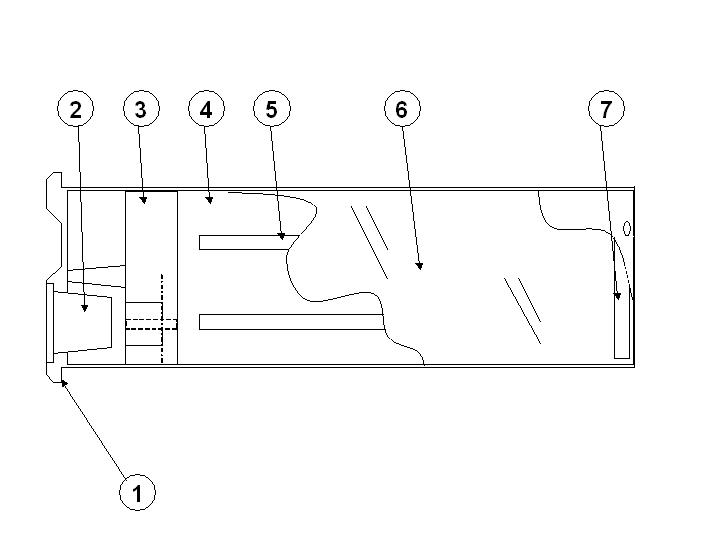Infrared decoy flare on:
[Wikipedia]
[Google]
[Amazon]
A flare or decoy flare is an aerial 

 Flares burn at thousands of degrees Celsius, which is much hotter than the exhaust of a jet engine. IR missiles seek out the hotter flame, believing it to be an aircraft in
Flares burn at thousands of degrees Celsius, which is much hotter than the exhaust of a jet engine. IR missiles seek out the hotter flame, believing it to be an aircraft in 


 For the infrared generating charge, two approaches are possible: pyrotechnic and
For the infrared generating charge, two approaches are possible: pyrotechnic and  Square calibres and typical decoy flares:
* 1x1x8 Inch e.g. M-206, MJU-61, ( Magnesium/Teflon/Viton (MTV) based) M-211, M-212 (spectral flares)
* 2x1x8 Inch e.g. MJU-7A/B (MTV based), MJU-59/B (spectral flare)
* 2x2.5x8 Inch e.g. MJU-10/B (MTV based)
Cylindrical calibres and typical decoy flares:
* 2.5 Inch e.g. MJU-23/B (MTV based)
* 1.5 Inch e.e. MJU 8 A/B (MTV based)
* 1 Inch e.g. PPI 26 IW
Square calibres and typical decoy flares:
* 1x1x8 Inch e.g. M-206, MJU-61, ( Magnesium/Teflon/Viton (MTV) based) M-211, M-212 (spectral flares)
* 2x1x8 Inch e.g. MJU-7A/B (MTV based), MJU-59/B (spectral flare)
* 2x2.5x8 Inch e.g. MJU-10/B (MTV based)
Cylindrical calibres and typical decoy flares:
* 2.5 Inch e.g. MJU-23/B (MTV based)
* 1.5 Inch e.e. MJU 8 A/B (MTV based)
* 1 Inch e.g. PPI 26 IW
 Other payloads provide large amounts of hot
Other payloads provide large amounts of hot
infrared countermeasure
An infrared countermeasure (IRCM) is a device designed to protect aircraft from infrared homing ("heat seeking") missiles by confusing the missiles' infrared guidance system so that they miss their target (electronic countermeasure). Heat-see ...
used by a plane or helicopter to counter an infrared homing ("heat-seeking") surface-to-air missile or air-to-air missile. Flares are commonly composed of a pyrotechnic composition
A pyrotechnic composition is a substance or mixture of substances designed to produce an effect by heat, light, sound, gas/smoke or a combination of these, as a result of non-detonative self-sustaining exothermic chemical reactions. Pyrotechnic s ...
based on magnesium
Magnesium is a chemical element with the symbol Mg and atomic number 12. It is a shiny gray metal having a low density, low melting point and high chemical reactivity. Like the other alkaline earth metals (group 2 of the periodic ta ...
or another hot-burning metal, with burning temperature equal to or hotter than engine exhaust. The aim is to make the infrared-guided missile seek out the heat signature from the flare rather than the aircraft's engines.

Tactics
In contrast to radar-guided missiles
In military terminology, a missile is a guided airborne ranged weapon capable of self-propelled flight usually by a jet engine or rocket motor. Missiles are thus also called guided missiles or guided rockets (when a previously unguided rocket i ...
, IR-guided missiles are very difficult to find as they approach aircraft. They do not emit detectable radar, and they are generally fired from behind, directly toward the engines. In most cases, pilots have to rely on their wingmen to spot the missile's smoke trail and alert of a launch. Since IR-guided missiles have a shorter range than their radar-guided counterparts, good situational awareness of altitude and potential threats continues to be an effective defense. More advanced electro-optical
Electro–optics is a branch of electrical engineering, electronic engineering, materials science, and material physics involving components, electronic devices such as lasers, laser diodes, LEDs, waveguides, etc. which operate by the propag ...
systems can detect missile launches automatically from the distinct thermal emissions of a missile's rocket motor.
Once the presence of a "live" IR missile is indicated, flares are released by the aircraft in an attempt to decoy
A decoy (derived from the Dutch ''de'' ''kooi'', literally "the cage" or possibly ''ende kooi'', " duck cage") is usually a person, device, or event which resembles what an individual or a group might be looking for, but it is only meant to lu ...
the missile. Some systems are automatic, while others require manual jettisoning of the flares. The aircraft would then pull away at a sharp angle from the flare (and the terminal trajectory of the missile) and reduce engine power in attempt to cool the thermal signature. Ideally the missile's seeker head is then confused by this change in temperature and flurry of new heat signatures, and starts to follow one of the flares rather than the aircraft.
More modern IR-guided missiles have sophisticated on-board electronics and secondary electro-optical sensors that help discriminate between flares and targets, reducing the effectiveness of flares as a reactionary countermeasure. A newer procedure involves preemptively deploying flares in anticipation of a missile launch, which distorts the expected image of the target should one be let loose. This "pre-flaring" increases the chances that the missile then follows the flares or the open sky in between, rather than a part of the actual defender.
As non-state combatants such as insurgents and terrorists gain access to anti-air missiles, there is an increasing trend to equip slower-moving helicopters with flare countermeasures. Consequently, flare dispensers have become a regular feature on military helicopters. Almost all of the UK's helicopters, whether they are transport or attack models, are equipped with flare dispensers or missile approach warning systems. Similarly, the US armed forces have adopted active defenses with their helicopters.
Usage
Apart from military use, some civilian aircraft are also equipped with countermeasure flares, againstterrorism
Terrorism, in its broadest sense, is the use of criminal violence to provoke a state of terror or fear, mostly with the intention to achieve political or religious aims. The term is used in this regard primarily to refer to intentional violen ...
: the Israel
Israel (; he, יִשְׂרָאֵל, ; ar, إِسْرَائِيل, ), officially the State of Israel ( he, מְדִינַת יִשְׂרָאֵל, label=none, translit=Medīnat Yīsrāʾēl; ), is a country in Western Asia. It is situated ...
i airline El Al
El Al Israel Airlines Ltd. (, he, אל על נתיבי אויר לישראל בע״מ), trading as El Al (Hebrew: , "Upwards", "To the Skies" or "Skywards", stylized as ELAL; ar, إل-عال), is the flag carrier of Israel. Since its inaugura ...
, having been the target of the failed 2002 airliner attack, in which shoulder-launched surface-to-air missiles were fired at an airliner while taking off, began equipping its fleet with radar-based, automated flare release countermeasures from June 2004. This caused concerns in some European countries, which proceeded to ban such aircraft from landing at their airports.
Decoying

afterburner
An afterburner (or reheat in British English) is an additional combustion component used on some jet engines, mostly those on military supersonic aircraft. Its purpose is to increase thrust, usually for supersonic flight, takeoff, and co ...
or the beginning of the engine's exhaust source.
As the more modern infrared seekers tend to have spectral sensitivity tailored to more closely match the emissions of airplanes and reject other sources (the so-called CCM, or counter-countermeasures), the modernized decoy flares have their emission spectrum optimized to also match the radiation of the airplane (mainly its engines and engine exhaust). In addition to spectral discrimination, the CCMs can include trajectory discrimination and detection of size of the radiation source.
The newest generation of the FIM-92 Stinger
The FIM-92 Stinger is an American man-portable air-defense system (MANPADS) that operates as an infrared homing surface-to-air missile (SAM). It can be adapted to fire from a wide variety of ground vehicles, and from helicopters as the Air-t ...
uses a dual IR and UV seeker head, which allows for a redundant tracking solution, effectively negating the effectiveness of modern decoy flares (according to the U.S. Department of Defense
The United States Department of Defense (DoD, USDOD or DOD) is an executive branch department of the federal government charged with coordinating and supervising all agencies and functions of the government directly related to national secur ...
). While research and development in flare technology has produced an IR signature on the same wavelength as hot engine exhaust, modern flares still produce a notably (and immutably) different UV signature than an aircraft engine burning kerosene jet-fuel.

Materials used


 For the infrared generating charge, two approaches are possible: pyrotechnic and
For the infrared generating charge, two approaches are possible: pyrotechnic and pyrophoric
A substance is pyrophoric (from grc-gre, πυροφόρος, , 'fire-bearing') if it ignites spontaneously in air at or below (for gases) or within 5 minutes after coming into contact with air (for liquids and solids). Examples are organolit ...
as stored, chemical-energy-source IR-decoy flares contain pyrotechnic
Pyrotechnics is the science and craft of creating such things as fireworks, safety matches, oxygen candles, explosive bolts and other fasteners, parts of automotive airbags, as well as gas-pressure blasting in mining, quarrying, and demolition. ...
compositions, liquid or solid pyrophoric substances, or liquid or solid highly flammable substances.
Upon ignition of the decoy flare, a strongly exothermal reaction is started, releasing infrared energy and visible smoke and flame, emission being dependent on the chemical nature of the payload used.
There is a wide variety of calibres and shapes available for aerial decoy flares. Due to volume storage restrictions on board platforms, many aircraft of American origin use square decoy flare cartridges. Nevertheless, cylindrical cartridges are also available on board American aircraft, such as MJU 23/B on the B-1 Lancer
The Rockwell B-1 Lancer is a supersonic variable-sweep wing, heavy bomber used by the United States Air Force. It is commonly called the "Bone" (from "B-One"). It is one of three strategic bombers serving in the U.S. Air Force fleet along with ...
or MJU-8A/B on the F/A-18 Hornet; however, these are used mainly on board French aircraft and those of Russian origin (e.g. PPI-26 IW on the MiG 29
The Mikoyan MiG-29 (russian: Микоян МиГ-29; NATO reporting name: Fulcrum) is a twin-engine fighter aircraft designed in the Soviet Union. Developed by the Mikoyan design bureau as an air superiority fighter during the 1970s, the ...
).
Pyrotechnic flares
Pyrotechnic flares use a slow-burning fuel-oxidizer mixture that generates intense heat.Thermite
Thermite () is a pyrotechnic composition of metal powder and metal oxide. When ignited by heat or chemical reaction, thermite undergoes an exothermic reduction-oxidation (redox) reaction. Most varieties are not explosive, but can create brie ...
-like mixtures, e.g. Magnesium/Teflon/Viton (MTV), are common. Other combinations include ammonium perchlorate/anthracene
Anthracene is a solid polycyclic aromatic hydrocarbon (PAH) of formula C14H10, consisting of three fused benzene rings. It is a component of coal tar. Anthracene is used in the production of the red dye alizarin and other dyes. Anthracene is col ...
/magnesium, or can be based on red phosphorus
Elemental phosphorus can exist in several allotropes, the most common of which are white and red solids. Solid violet and black allotropes are also known. Gaseous phosphorus exists as diphosphorus and atomic phosphorus.
White phosphorus
White ...
.
To adjust the emission characteristics to match closer the spectrum of jet engines, charges on the base of double base propellants. These compositions can avoid the metal content and achieve cleaner burning without the prominent smoke trail.
Blackbody payloads
Certain pyrotechnic compositions, for example MTV, give a great flame emission upon combustion and yield a temperature-dependent signature and can be understood as gray bodies of highemissivity
The emissivity of the surface of a material is its effectiveness in emitting energy as thermal radiation. Thermal radiation is electromagnetic radiation that most commonly includes both visible radiation (light) and infrared radiation, which is n ...
(~0.95). Such payloads are called blackbody
A black body or blackbody is an idealized physical body that absorbs all incident electromagnetic radiation, regardless of frequency or angle of incidence. The name "black body" is given because it absorbs all colors of light. A black body ...
payloads. Other payloads, like iron/potassium perchlorate pellets, only yield a low flame emission but also show temperature-dependent signature. Nevertheless, the lower combustion temperature as compared to MTV results in a lower amount of energy released in the short-wavelength IR range. Other blackbody payloads include ammonium perchlorate/anthracene/magnesium and hydroxyl-terminated polybutadiene (HTPB Hydroxyl-terminated polybutadiene (HTPB) is an oligomer of butadiene terminated at each end with a hydroxyl functional group. It reacts with isocyanates to form polyurethane polymers.
HTPB is a translucent liquid with a color similar to wax paper ...
) binder.
Spectrally balanced payloads
 Other payloads provide large amounts of hot
Other payloads provide large amounts of hot carbon dioxide
Carbon dioxide ( chemical formula ) is a chemical compound made up of molecules that each have one carbon atom covalently double bonded to two oxygen atoms. It is found in the gas state at room temperature. In the air, carbon dioxide is trans ...
upon combustion and thus provide a temperature-independent selective emission in the wavelength range between 3 and 5 μm. Typical pyrotechnic payloads of this type resemble whistling compositions and are often made up from potassium perchlorate and hydrogen lean organic fuels. Other spectrally balanced payloads are made up similarly as double base propellants and contain nitrocellulose
Nitrocellulose (also known as cellulose nitrate, flash paper, flash cotton, guncotton, pyroxylin and flash string, depending on form) is a highly flammable compound formed by nitrating cellulose through exposure to a mixture of nitric acid and ...
(NC), and other esters of nitric acid or nitro compound
In organic chemistry, nitro compounds are organic compounds that contain one or more nitro functional groups (). The nitro group is one of the most common explosophores (functional group that makes a compound explosive) used globally. The nitr ...
s as oxidizers such as hexanitroethane and nitro compounds and nitramine
Nitramide is a chemical compound with the molecular formula H2NNO2. Organyl derivatives of nitramide, RNHNO2 are termed nitroamines, and are widely used as explosives: examples include RDX and HMX. It is an isomer of hyponitrous acid.
Struct ...
s as high-energy fuels.
Pyrophoric flares
Pyrophoric flares work on the principle of ejecting a special pyrophoric material out of an airtight cartridge, usually using agas generator
A gas generator is a device for generating gas. A gas generator may create gas by a chemical reaction or from a solid or liquid source, when storing a pressurized gas is undesirable or impractical.
The term often refers to a device that uses a ...
, e.g. a small pyrotechnic charge or pressurized gas. The material then self-ignites in contact with air. The materials can be solid, e.g. iron platelets coated with ultrafine aluminium
Aluminium (aluminum in American and Canadian English) is a chemical element with the symbol Al and atomic number 13. Aluminium has a density lower than those of other common metals, at approximately one third that of steel. I ...
, or liquid, often organometallic compounds; e.g. alkyl aluminium compounds, e.g. triethylaluminium
Triethylaluminium is one of the simplest examples of an organoaluminium compound. Despite its name it has the formula Al2( C2H5)6 (abbreviated as Al2Et6 or TEA), as it exists as a dimer. This colorless liquid is pyrophoric. It is an industrially ...
. Pyrophoric flares may have reduced effectiveness at high altitudes, due to lower air temperature and lower availability of oxygen; however oxygen can be co-ejected with the pyrophoric fuel.
The advantage of alkyl aluminium and similar compounds is the high content of carbon and hydrogen, resulting in bright emission lines similar to spectral signature of burning jet fuel. Controlled content of solid combustion products, generating continuous black-body radiation, allows further matching of emission characteristics to the net infrared emissions of fuel exhaust and hot engine components.
The flames of pyrophoric fuels can also reach the size of several metres, in comparison with about less than one metre flame of MTV flares. The trajectory can be also influenced by tailoring the aerodynamic properties of the ejected containers.
Solid pyrophoric payloads are based on iron platelets coated with a porous aluminium layer. Based on the very high specific surface area of aluminium those platelets instantaneously oxidize upon contact with air. In contrast to triethylaluminium combustion, these platelets yield a temperature-dependent signature.
Highly flammable payloads
These payloads containred phosphorus
Elemental phosphorus can exist in several allotropes, the most common of which are white and red solids. Solid violet and black allotropes are also known. Gaseous phosphorus exists as diphosphorus and atomic phosphorus.
White phosphorus
White ...
as an energetic filler. The red phosphorus is mixed with organic binders to give brushable pastes that can be coated on thin polyimide platelets. The combustion of those platelets yields a temperature-dependent signature. Endergonic additives such as highly dispersed silica
Silicon dioxide, also known as silica, is an oxide of silicon with the chemical formula , most commonly found in nature as quartz and in various living organisms. In many parts of the world, silica is the major constituent of sand. Silica is ...
or alkali halides may further lower the combustion temperature.H. Bannasch, M. Wegscheider, M. Fegg, H. Büsel, Spektrale Scheinzielanpassung und dazu verwendbare Flarewirkmasse, WO 95/05572, 1995, D.
See also
* Anti-aircraft * Anti-ballistic missile *Chaff (countermeasure)
Chaff, originally called Window by the British and ''Düppel'' by the Second World War era German Luftwaffe (from the Berlin suburb where it was first developed), is a radar countermeasure in which aircraft or other targets spread a cloud of sm ...
* Countermeasure
A countermeasure is a measure or action taken to counter or offset another one. As a general concept, it implies precision and is any technological or tactical solution or system designed to prevent an undesirable outcome in the process. The fi ...
* Electronic countermeasure
* Infrared countermeasure
An infrared countermeasure (IRCM) is a device designed to protect aircraft from infrared homing ("heat seeking") missiles by confusing the missiles' infrared guidance system so that they miss their target (electronic countermeasure). Heat-see ...
References
{{Reflist Articles containing video clips Missile countermeasures Pyrotechnics